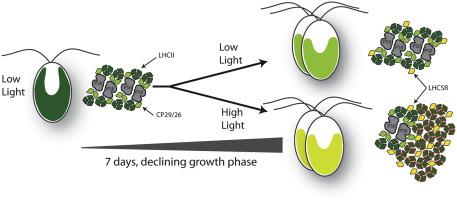Plant Physiology and Biochemistry ( IF 6.5 ) Pub Date : 2020-12-04 , DOI: 10.1016/j.plaphy.2020.12.002 Emily Meagher , Pattarasiri Rangsrikitphoti , Babar Faridi , Ghaith Zamzam , Dion G. Durnford

|
Microalgae can respond to long-term increases in light intensity by altering the concentration of photosynthetic complexes. Under active growth, the ability of Chlamydomonas reinhardtii to acclimate to excess light is dependent on cell division to reduce the concentration of photosynthetic complexes. But, in batch culture, cells eventually reach stationary phase where their ability to divide is limited; this should impact their capacity to undergo photoacclimation. Our goal is to dissect excess-light responses as cells approach stationary phase and to determine how the strategies of photoacclimation differ compared to cells in the exponential-growth phase. In this study, cultures exited exponential growth and transitioned into a declining growth phase (DGP), where cells continued a slow rate of growth for the next seven days in both low (LL) and high-light (HL). During this period, both cultures experience a conditional senescence-related decline in chlorophyll levels. Under HL, however, the senescing cultures have a rapid decline in PSII reaction centres, maintain a stable concentration of LHCII antenna, rapidly increase LHCSR levels, and have a sustained increase in Fo/Fm. Collectively this implies that the remaining antenna act as pH-dependent, quenching centres, presumably to protect the senescing chloroplast against HL. We discovered that acclimating to HL post-exponential phase involves active degradation that is intertwined with the normal senescence process that allowed for a limited rate of cell division.
中文翻译:

在条件性衰老过程中,莱茵衣藻对高光胁迫的光驯化依赖于产生依赖pH的高猝灭中心
微藻可以通过改变光合复合物的浓度来应对光强度的长期增加。在活跃的增长下,莱茵衣藻的能力适应过多的光取决于细胞分裂以降低光合复合物的浓度。但是,在分批培养中,细胞最终会达到分裂分裂能力受限的静止期。这将影响他们的光适应能力。我们的目标是在细胞接近固定相时解剖过量的光响应,并确定光适应策略与指数生长相中的细胞相比有何不同。在这项研究中,培养物退出了指数生长,并进入了下降的生长阶段(DGP),在此阶段中,细胞在低光(LL)和高光(HL)下连续七天继续缓慢生长。在此期间,两种培养物的叶绿素水平都有条件的与衰老相关的下降。但是,根据HL,敏感的文化在PSII反应中心迅速减少,保持LHCII触角稳定浓度,迅速增加LHCSR水平,并且Fo / Fm持续增加。总的来说,这意味着剩余的天线充当了pH依赖的猝灭中心,大概是为了保护敏感的叶绿体免受HL的伤害。我们发现,适应HL的指数后阶段涉及主动降解,该降解与允许细胞分裂速率受限的正常衰老过程交织在一起。


























 京公网安备 11010802027423号
京公网安备 11010802027423号